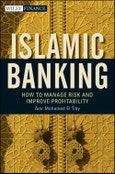The guiding principle of Islamic finance has existed throughout Islamic history, yet modern Islamic banking has been around for a relatively short period of time. Author Amr Mohamed El Tiby is an expert in this field, and with this new book, he reveals how you can benefit from the use of Islamic banking strategies in your financial endeavors.
Engaging and accessible, Islamic Banking shows the impact this approach has made on conventional banking since the 1950s, and why it's such a big player in the current market. It offers a unique look at various aspects of this field, including the salient features of Islamic banking that distinguishes it from non-Islamic banking, the development of the regulatory bodies and supervisory agencies that support the Islamic banking system, and much more. It also explores the nature of risk in Islamic banking and the issues of capital adequacy, corporate governance, transparency, and risk associated with Islamic banking.
- Discusses the history and development of Islamic finance
- Offers straightforward strategies for implementing Islamic finance into your business activities
- Sheds light on the effect of the global economic crisis on Islamic banks versus conventional banks
Filled with in-depth insights and expert advice, this detailed analysis of Islamic finance will help you gain a firm understanding of how effective this proven approach can be.
Table of Contents
List of Tables.Foreword.
Preface.
Acknowledgments.
Introduction.
Part I: Understanding the Origins.
Chapter 1: Introduction to Islamic Banking.
Chapter 2: History and Development of Islamic Banking.
Part II: Risk in Islamic Banking.
Chapter 3: The Nature of Risk in Islamic Banking.
Chapter 4: The Inherent Risk in Islamic Banking Instruments.
Chapter 5: Operational Risk in Islamic Banking.
Chapter 6: The Islamic Capital Market.
Part III: Capital Adequacy.
Chapter 7: The Importance and Role of Capital Literature Review.
Chapter 8: The Regulatory Framework of the Conventional Banking System: Basel I and II.
Chapter 9: The Regulatory Framework of Islamic Banks.
Part IV: Corporate Governance.
Chapter 10: The Supervisory Review Process and Issues.
Chapter 11: Corporate Governance in Islamic Banking.
Chapter 12: Market Discipline and Transparency in Islamic Banking.
Chapter 13: Challenges Facing Islamic Banking and Recommendations.
Abbreviations.
Glossary.
References.
About the Author.
Index.








